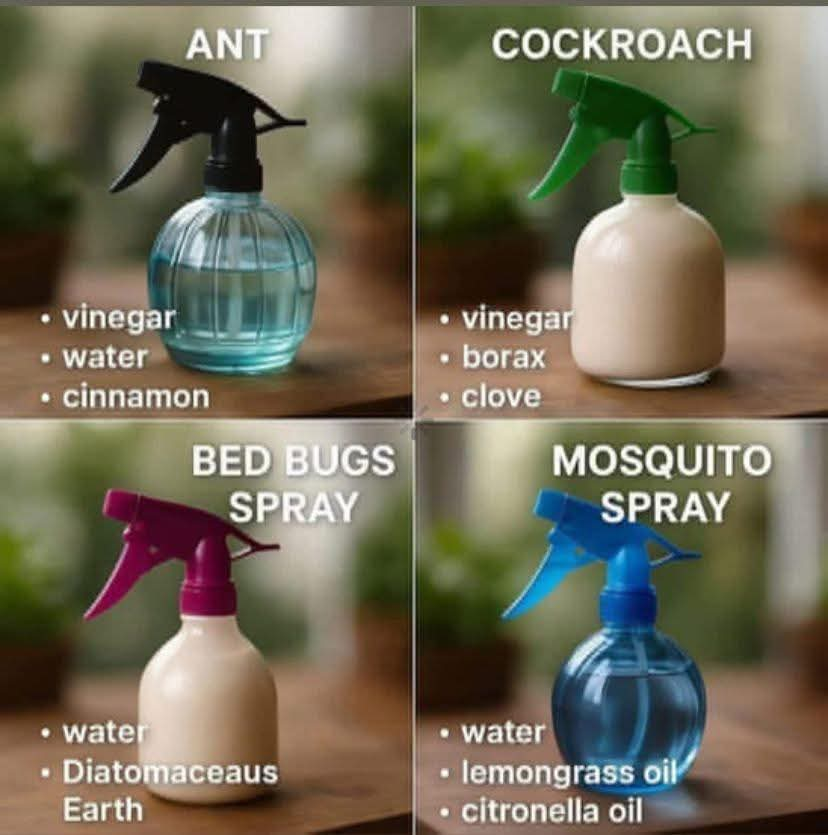Certainly! Here’s a complete structured write-up for your Natural Bed Bug Spray, following your requested format:
Say Goodbye to Ants, Cockroaches, Bed Bugs & Mosquitoes—Naturally!
Bed Bug Spray
Introduction
Bed bugs are notorious for being one of the hardest household pests to get rid of. They hide in the tiniest crevices, come out at night, and leave behind itchy.
irritating bites. Chemical treatments can be effective but are often costly, toxic, and disruptive to your home life.
Fortunately, nature has given us safer alternatives that are just as effective when used consistently and correctly.
Ingredients
Mix 1 cup water + 1 tbsp diatomaceous earth
Shake well before each use
Tip: Mist lightly on mattresses & corners. Avoid breathing powder while spraying.
Instructions
Begin by selecting a clean spray bottle that can deliver a fine mist. This ensures even coverage and prevents clumping of the diatomaceous earth, which can reduce its effectiveness.
Pour one cup of water into the spray bottle. Use filtered or distilled water if possible to avoid any mineral buildup or impurities that could affect the mixture.
Add one tablespoon of food-grade diatomaceous earth. It’s crucial to use only food-grade DE, as other forms may contain harmful additives or be unsafe for indoor use.
Tightly seal the spray bottle and shake it well. Since diatomaceous earth is a fine powder, it may settle quickly, so thorough shaking is necessary before every use.
Before applying the spray widely, test it on a small, hidden section of your mattress or upholstery. This ensures that the mixture does not stain or damage fabric.
Mist lightly over the surface of mattresses, box springs, bed frames, headboards, and baseboards. Focus on seams, folds, and cracks where bed bugs are known to hide.
Avoid direct inhalation of the mist. While diatomaceous earth is natural, the fine powder can irritate your lungs if breathed in during application.
How to Make
Choose a spray bottle that has a fine misting nozzle rather than a stream sprayer. This helps disperse the solution evenly and minimizes buildup of the powder.
Use only food-grade diatomaceous earth, which is safe for indoor use around pets and humans. Pool-grade versions are not safe for use in living spaces and should be avoided.
Boil the water if needed, and let it cool before adding it to your spray bottle. This step isn’t mandatory but can help with better mixing and longer shelf life.
Slowly pour the cooled water into the bottle. Fill it about halfway first, then add the diatomaceous earth to reduce clumping and overflow.
Add the tablespoon of diatomaceous earth. A funnel can be useful to prevent powder from spilling and ensure a smooth transfer into the bottle.
Finish filling the bottle with the remaining water, then screw on the lid and shake thoroughly. You should see a cloudy mixture that evenly suspends the powder.
Label your spray bottle clearly with the contents and date. Shake well before each use, as the powder will naturally settle at the bottom over time.
Variations
Add a few drops of lavender or tea tree essential oil for a soothing scent and added bed bug repelling power. Both oils are natural insect deterrents.
Mix in witch hazel instead of water for a version that dries faster and provides a mild antibacterial effect, especially useful on fabric surfaces.
Use distilled white vinegar as a partial base. A half-and-half mix with water can increase the spray’s effectiveness while still being gentle on surfaces.
Infuse the water beforehand with dried herbs like rosemary or eucalyptus. Strain before mixing to ensure no debris clogs your spray nozzle.
Instead of spraying, dust pure diatomaceous earth around bed legs and corners using a dry applicator. This works as a complement to the mist spray.
Add lemon or citrus essential oils if you prefer a fresher scent and want to enhance the mixture’s natural repellent properties.
If you’re targeting luggage or furniture, lightly mist the spray over seams and zippers. You can also spray into cracks in drawers and wooden bed frames.
Tips
Always shake the bottle before each use. The powder will settle quickly, and an even mix is key for the spray to remain effective.
Mist lightly rather than saturating surfaces. Too much moisture can cause the powder to clump and lose its effectiveness.
Avoid spraying near fans, open windows, or direct airflow to prevent airborne particles of diatomaceous earth from being inhaled.
Use a mask if you’re especially sensitive or prone to respiratory issues. While the spray is natural, inhaling any fine powder isn’t recommended.
Reapply the spray every few days or after cleaning. Consistent use is important, as bed bugs are persistent and can hide in hard-to-reach places.
Vacuum and clean infested areas regularly in addition to using the spray. Diatomaceous earth works best when combined with good hygiene practices.
Store the bottle in a cool, dry place. Avoid leaving it in hot or humid environments, which can affect the consistency and shelf life of the solution.
Conclusion
Bed bugs can turn your sanctuary into a stressful battleground, but harsh chemicals aren’t your only option. With just water and diatomaceous earth, you can create a safe, natural spray that fights back against infestations while protecting your family and your health.
This gentle mist offers peace of mind and promotes better sleep by addressing pests without introducing toxins into your living space. Embrace this easy, eco-friendly solution and rest easy knowing you’ve taken a clean, conscious approach to pest control.
Let me know if you’d like to continue with the mosquito spray next!
